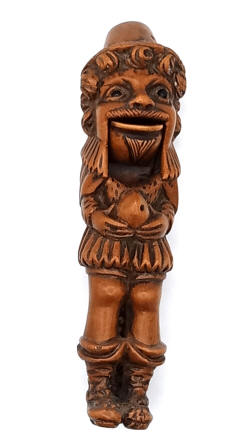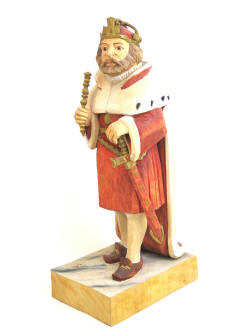4th Quarter Newsletter 2024
for the Leavenworth Nutcracker Museum
This page is best viewed on a PC or tablet.
WHAT’S HIDDEN IN THE BACK?
Many of the nutcrackers in the museum
have interesting back levers that are never seen by the visitors yet add
to the uniqueness of the piece. A sitting Chinese figure opens its mouth
to receive the nut as his long braid is lifted. An 18th century couple
from the Groeden Valley in Italy open their mouths as the baskets on
their backs are lifted, Mattias Freund of Germany carved a king whose
cape lifts to crack the nut, and the back handle for a Pierrot serves as
a chair as he plays his mandolin.
 |
 |
This oakwood nutcracker is
from England, and is only 5.5 inches tall. It is typical of 17th
Century carvings. |
| |
|
|
 |
 |
Flower shaped engravings decorate the back
of this boxwood nutcracker. Late 17th Century, Holland. |
| |
|
|
 |
 |
This Lady in ruffled bonnet has initials of
AT on the front and the face of a man on the back lever. Walnut
wood, early 19th Century, Italy. |
| |
|
|
 |
 |
A snake temps with a bottle while a second
acts as the back handle showing the evils of alcohol. Yew wood, 19th
Century, France. |
| |
|
|
 |
 |
This early King with shield is carved of
linden wood but is missing his ivory teeth. Early 19th Century,
Switzerland. |
| |
|
|
 |
 |
This Alsace gentleman with wig is carved of
fruitwood. 18th Century, France. Most Alsace nutcrackers have a
front cavity to receive the nut. |
| |
|
|
 |
 |
This King, with a bird on the head denoting
royalty, was carved in France of boxwood. At 1569, it is one of the
world’s oldest dated nutcrackers. |
Contact Us
Open Daily 11-5
We suggest visitors arrive at least 30 minutes before closing.


